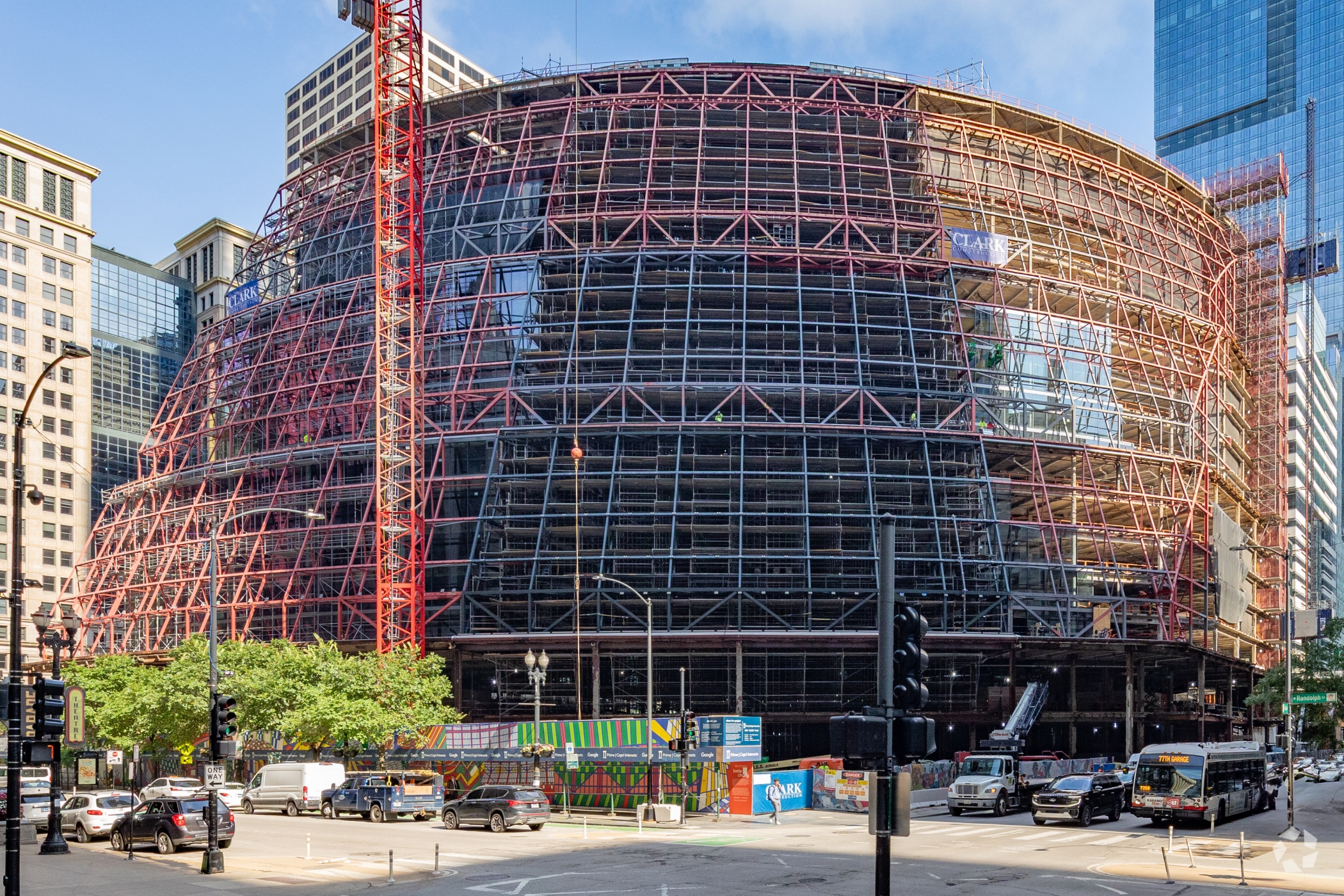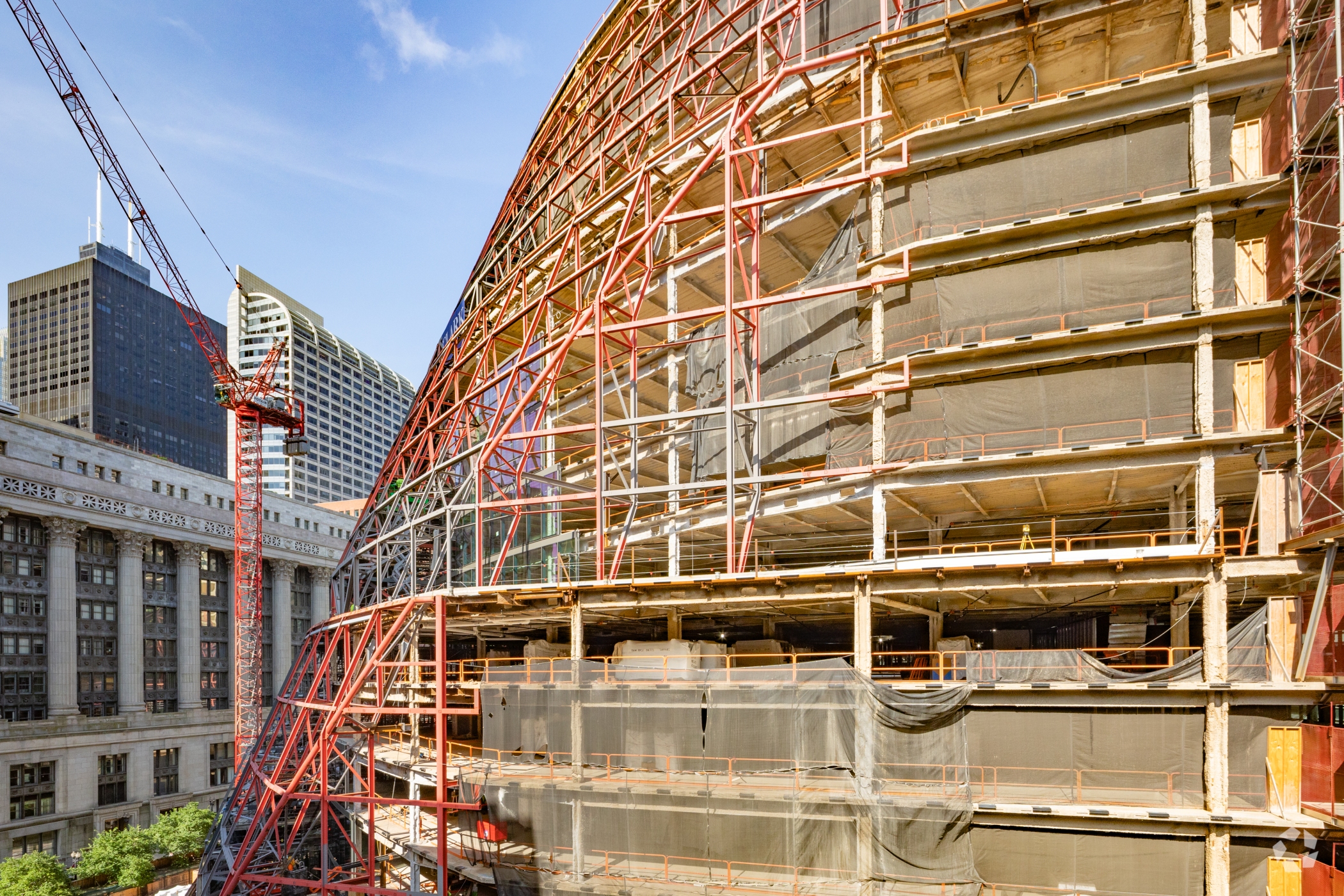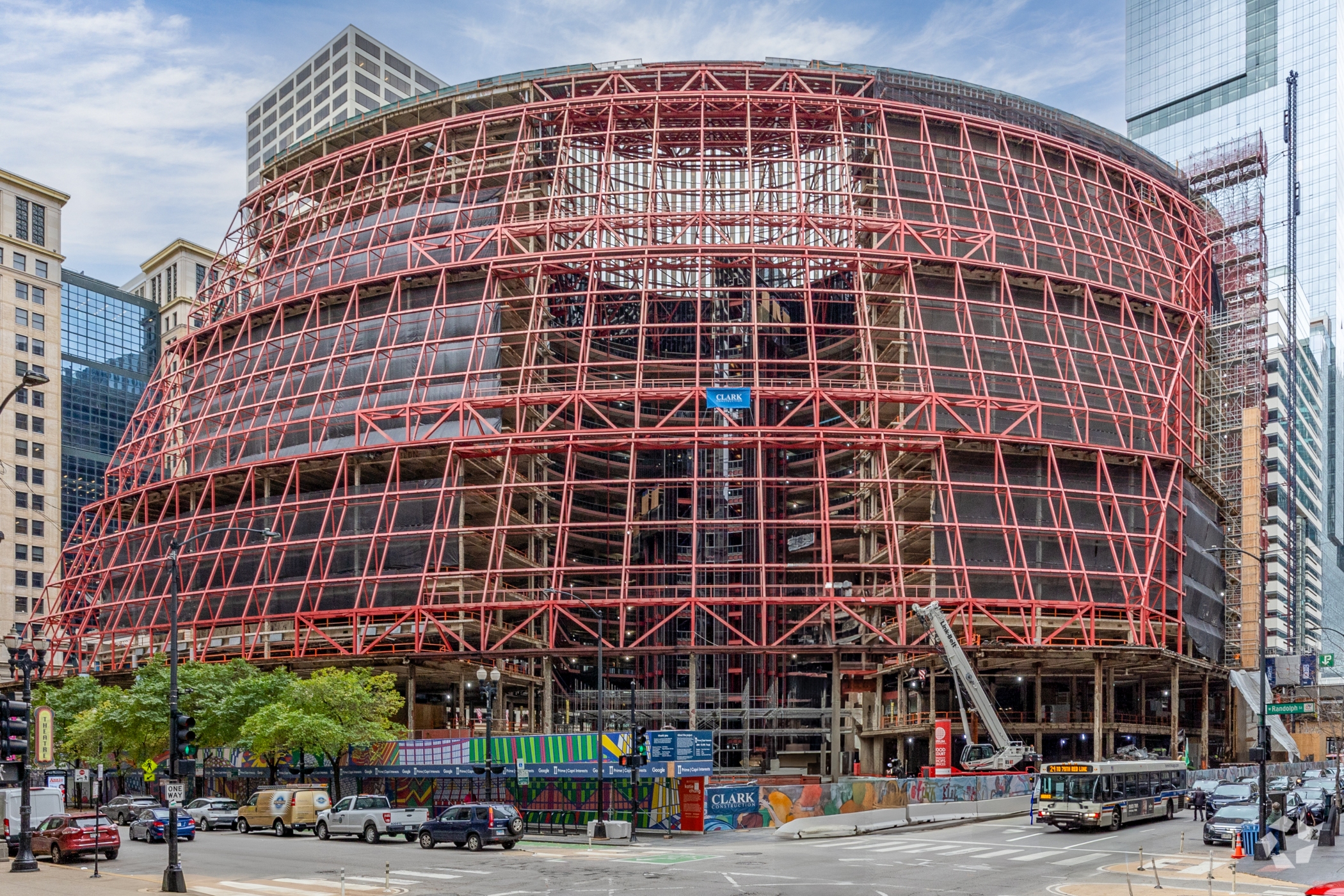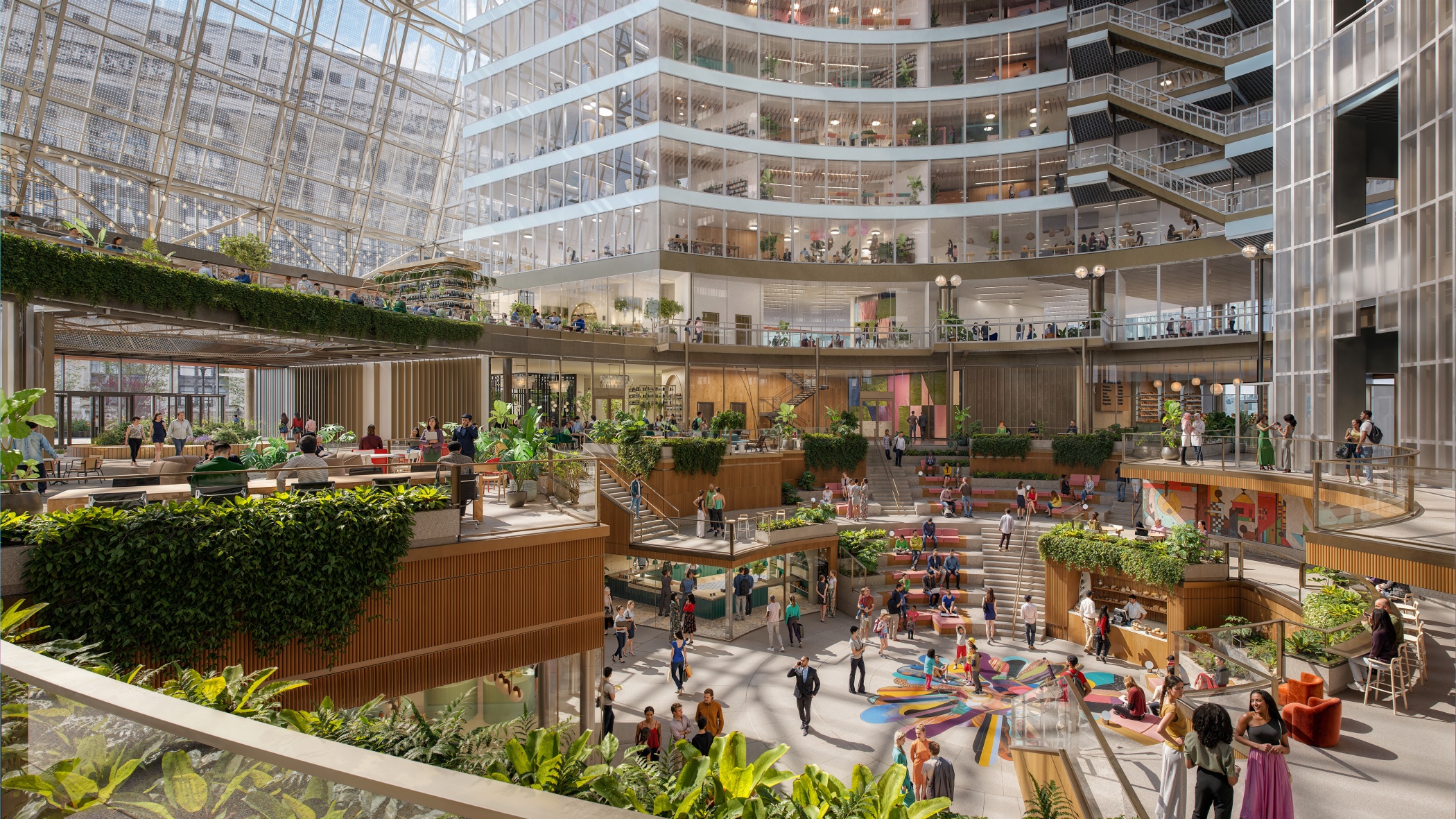Tech giant Google’s reshaping of one of Chicago’s quirkiest buildings is coming into clearer view for downtown workers and elevated train passengers, with the once-skeletal exterior of the James R. Thompson Center taking on an eye-catching, new glass exterior.
As the gutting of the formerly state-owned government building plows toward an expected 2027 completion, it is securing its place as one of the most-watched real estate projects ever in Chicago. That's partly because of high hopes that Google’s building modernization can boost the sagging Loop office market and in part because of the Thompson Center’s high-profile setting.
The ultrawide building at 100 W. Randolph St., designed by well-known architect Helmut Jahn and widely considered an iconic structure, sits on a site spanning about 3 acres in the center of downtown, directly connected to most of the Chicago Transit Authority’s train lines and surrounded by a public plaza.
The arrival in recent weeks of rows of glass panels along the Lake Street side has provided the best public look so far at how the 17-story structure will appear when the revamping is complete; most of that process is required to happen before Google will complete its purchase and move-in.

While it remains to be seen exactly how many people Google will employ in the 1.2 million-square-foot building or how much the project might improve the prospects for office leasing, residential conversions and property values in the area, real estate professionals agree the project is winning when it comes to attracting stares and starting conversations.
“It’s driving the narrative in the central Loop,” said Matt Garrison, CEO of Chicago developer R2, a firm not involved in the project. “The Thompson Center is making its way into every offering memorandum and every lease pitch.”
Pivotal time
Talk of how to turn around the core of the Loop and its older buildings already was at a peak when CoStar News broke the story in 2022 that Google was in talks to buy the Thompson Center. The Mountain View, California-based online search giant confirmed the market-shifting deal about a month later.
Google’s unusually structured deal for the building came after two local firms led by well-known real estate Chicago figures — Mike Reschke’s Prime Group and Quintin Primo’s Capri Investment Group — already had agreed to buy the Thompson Center from the state of Illinois, which for years had looked to sell the property and move state workers to other properties.

After Google’s interest emerged, Prime Group and Capri Investment agreed to pay the state $30 million in cash and shift ownership of a nearby office building valued at $75 million.
The developers and local and state officials held a groundbreaking celebration after work began in 2024.
Google’s reputation as a forward-thinking real estate owner and tenant has altered the way the Thompson Center is perceived, after years facing the prospect of being demolished.
“It adds an instant dose of credibility,” said longtime Chicago office leasing broker Michael Lirtzman of Colliers. “The perception is, if it’s good enough for Google, it should be good enough for other people.
“There’s a lot of curiosity about it. Is this the kind of project that can give a market a shot in the arm? Nationally, there certainly are a lot of eyes on it.”
Multiple Illinois governors, including current officeholder JB Pritzker, floated the idea of selling the building to a developer that either would redevelop it or tear it down to create a large development site.

Critics of the building that opened in 1985 long viewed it as an inefficient oddball in need of hundreds of millions of dollars in upgrades. The building’s many proponents fought for several years to preserve the spaceship-like structure as an important example of the work of German-born, Chicago-based architect Jahn.
One factor that helped preserve the building was the complex process that a teardown would have needed. That's because a developer would have been required to guarantee that train lines connected to the building would not be interrupted.
While the fate of the Thompson Center remained unclear, Jahn was killed in 2021 when he was struck by cars while riding a bike in Chicago’s suburbs. Jahn’s firm is the design architect and architect of record on the Google project.
The redo
Google unveiled a few exterior renderings in late 2023, including plans for the large outdoor plaza. In late 2024, the company provided the first interior renderings for the soaring atrium, where restaurants, retail and other amenities are planned.
The new design replaces the former salmon and light blue exterior color scheme for more of a glassy, transparent look.
Many details remain unknown, such as exactly when in 2027 the project is expected to be completed and how many people will work there. It is also unclear whether Google plans to move some or all of its workers from two large offices in the Fulton Market district west of the Loop.
Google had about 2,000 employees in Fulton Market at the time it struck the Thompson Center deal. A Google spokesperson declined to comment to CoStar News.
Another unknown is how much space, and for how long, Google might lease parts of the building to other office tenants. Brokers representing Google have provided tours to office tenants and their brokers for potential leases that could fill as much as 400,000 square feet or so on upper floors.
If Google does bring in other tenants, market professionals said it could be done in a way that leaves flexibility for Google to take back space and expand years down the line.
“Having one large user lock down several floors is probably not ideal,” said Savills office tenant broker Robert Sevim, who has toured the building. “Having a few smaller users is probably a better Rubik’s Cube for them to work with so that they do have more flexibility to move up in the building later.”
To the extent that Google does want to shed space and generate rent revenue, the company could benefit from an unusual time in which there are no new competitors nearby. Aside from a relatively small amount of space nearly completed in Fulton Market, there are no office projects underway to compete with what will be essentially new Thompson Center space, Sevim said.
“In a way, this is our current new construction option,” Sevim said. “Because of the way the building is designed and the amount of light and air they’re being careful not to lose, you have light coming in from the perimeter glass as well as from the internal spaces that are looking out into the atrium, and the atrium itself is glass.
"There isn’t an area of the building where you don’t have light and air, and that typically is among the top handful of drivers for tenants choosing a relocation opportunity. I think there’s likely to be more demand than supply for that kind of space."
Area in flux
Amid historically low office demand, many older towers in the Loop have faced an uncertain future.
Garrison’s firm is involved in the first of a planned series of city-backed projects to convert parts of older office buildings on and around LaSalle Street, the city’s longtime financial center, into affordable housing.
R2 is working with the Italian billionaire family that controls the Campari Group spirits empire to redevelop eight floors of office space within the tower at 79 W. Monroe St. into 117 apartments, 35% of which will have below-market, affordable rents.
It is part of a broader initiative, backed by Mayor Brandon Johnson, in which developers can receive public dollars to help pay for conversions. The dual goal is to eliminate older, unwanted office space while reducing the shortage of affordable apartments downtown.
City backers hope that a wave of new residents and thousands of Google workers arriving in the Loop in the next couple of years could boost office demand and bring in new restaurants and retail and neighborhood amenities such as grocery stores, returning some pre-pandemic vibrancy.
While there are high hopes of a Google effect that will cause interest in the surrounding blocks to surge, Lirtzman said it will be years before the project’s broader effects can be properly assessed.
“It has all the hallmarks of something that should reenergize the neighborhood, but there’s so much secular change happening in the city and the neighborhood,” Lirtzman said. “It would be premature to say this project in a vacuum has solved all the problems in the Loop, mainly because we haven’t seen the finished product yet.”
Market maker
Google has developed a reputation for succeeding as an early mover in real estate deals.
Google’s arrival in the Chelsea neighborhood of Manhattan is credited with increasing office, residential and retail demand.
The company occupies millions of square feet of space in and around Chelsea, including the hulking 111 Eighth Ave. building Google bought for $1.77 billion in 2010 and the Chelsea Market building that it bought for $2.4 billion in 2018. Google also leases space in the area at Pier 57.
Just south of those properties, Google bought the St. John’s Terminal building for $2.1 billion.
While it hasn’t previously bought its office space in Chicago, Google has shaken up the city’s office market more than once before. In 2012, the company signed a lease of more than 600,000 square feet to move its Motorola Mobility unit there from far north suburban Libertyville, Illinois. Google no longer owned Motorola Mobility by the time the move happened in 2014, but the major lease led to other office deals in the Mart, the art deco landmark on the Chicago River.
In 2015, Google moved its Chicago office from a River North building to Fulton Market. Its agreement to move into the former Fulton Market Cold Storage building was a pivotal moment in the meatpacking district’s transition into the city’s fastest-growing real estate market, with low-rise brick buildings giving way to office, residential and hotel towers.
Major office tenants that have since arrived in Fulton Market include the global headquarters of McDonald’s and Mondelez International.
“The fact that Google has all the data in the world and this is what they chose to do is a pretty good endorsement,” R2’s Garrison said of the Thompson Center project. “They tend to kind of create markets where they go, and there’s already a precedent in Chicago.”



